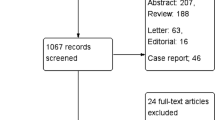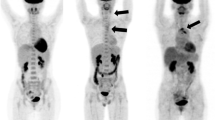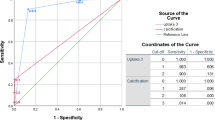Abstract
Objective
The purpose of this study was to evaluate the diagnostic performance of 18F-fluorodeoxyglucose positron-emission tomography (18F-FDG PET) or positron-emission tomography/computed tomography (PET/CT) for patients with large vessel vasculitis.
Methods
Based on a search in the PubMed, Embase, and Cochrane Library databases, a meta-analysis was performed on the diagnostic accuracy of 18F-FDG PET or PET/CT in patients with large vessel vasculitis.
Results
A total of eight studies involving 400 subjects (170 vasculitis patients and 230 controls) were selected for meta-analysis. The pooled sensitivity and specificity of 18F-FDG PET or PET/CT were 75.9 % (95 % confidence interval, CI 68.7–82.1) and 93.0 % (95 % CI 88.9–96.0), respectively. The positive likelihood ratio (PLR), negative likelihood ratio (NLR), and diagnostic odds ratio (DOR) were 7.267 (95 % CI 3.707–14.24), 0.303 (95 % CI 0.229–0.400), and 32.04 (95 % CI 13.08–78.45), respectively. The area under the curve (AUC) was 0.863 and the Q* index 0.794, indicating good diagnostic accuracy. There was no evidence of a threshold effect (Spearman’s correlation coefficient = 0.120, p = 0.776). When the data were limited to giant cell arteritis (GCA), the pooled sensitivity and specificity of 18F-FDG PET or PET/CT were 83.3 % (95 % CI 72.1–91.4) and 89.6 % (95 % CI 79.7–95.7), respectively; AUC was 0.884, and the Q* index 0.815, indicating modest accuracy with a small increase in diagnostic accuracy.
Conclusion
This meta-analysis of published studies demonstrates that 18F-FDG PET or PET/CT has good diagnostic accuracy for large vessel vasculitis and plays an important role in the diagnosis of this condition.
Zusammenfassung
Zielsetzung
The purpose of this study was to evaluate the diagnostic performance of 18F-fluorodeoxyglucose positron-emission tomography (18F-FDG PET) or positron-emission tomography/computed tomography (PET/CT) for patients with large vessel vasculitis.
Methoden
Auf der Basis von Recherchen in PubMed, Embase und Cochrane-Datenbanken wurde zur diagnostischen Genauigkeit von 18F-FDG PET bzw. PET/CT bei Patienten mit Vaskulitiden großer Gefäße eine Metaanalyse publizierter Untersuchungen durchgeführt.
Ergebnisse
Insgesamt 8 Studien (n=400, 170 Vaskulitispatienten, 230 Kontrollen) wurden in die Metaanalyse einbezogen. Gepoolte Sensitivität und Spezifität der 18F-FDG-PET bzw. PET/CT betrugen 75,9 % (95 %-Konfidenzintervall, KI, 68,7–82,1) bzw. 93,0 % (95 %-KI 88,9–96,0). Die positive (PLR) bzw. negative Vorhersagewahrscheinlichkeit (NLR) und die diagnostische Odds Ratio (DOR) betrugen 7267 (95 %-KI 3,707–14,24), 0,303 (95 %-KI 0,229–0,400) und 32,04 (95 %-KI 13,08–78,45). Die Fläche unter der Kurve (AUC) lag bei 0,863 und der Q*-Index bei 0,794, somit war eine gute diagnostische Genauigkeit nachgewiesen. Für einen Schwelleneffekt gab es keinen Hinweis (Spearman-Korrelationskoeffizient 0,120, p = 0,776). Bezog man die Ergebnisse nur auf die Riesenzellarteriitis (GCA), lagen für 18F-FDG PET bzw. PET/CT die gepoolte Sensitivität und Spezifität bei 83,3 % (95 %-KI 72,1–91,4) und 89,6 % (95 %-KI 79,7–95,7). Die AUC betrug 0,884, der Q*-Index bei 0,815, was für eine mäßige Genauigkeit mit einer geringen Verbesserung der diagnostischen Genauigkeit spricht.
Schlussfolgerung
Anhand einer Metaanalyse wurde gezeigt, dass die 18F-FDG PET und die PET/CT eine gute diagnostische Genauigkeit für Vaskulitiden großer Gefäße haben und eine wesentliche Rolle in ihrer Diagnostik einnehmen.



Similar content being viewed by others
References
Gulati A, Bagga A (2010) Large vessel vasculitis. Pediatr Nephrol 25(6):1037–1048
Hunder GG, Bloch DA, Michel BA et al (1990) The American College of Rheumatology 1990 criteria for the classification of giant cell arteritis. Arthritis Rheum 33(8):1122–1128
Arend WP, Michel BA, Bloch DA et al (1990) The American College of Rheumatology 1990 criteria for the classification of Takayasu arteritis. Arthritis Rheum33(8):1129–1134
Mukhtyar C, Guillevin L, Cid MC et al (2009) EULAR recommendations for the management of large vessel vasculitis. Ann Rheum Dis 68(3):318–323
Seo P, Stone JH (2004) Large‐vessel vasculitis. Arthritis Rheum 51(1):128–139
Ishimori T, Saga T, Mamede M et al (2002) Increased 18F-FDG uptake in a model of inflammation: concanavalin A-mediated lymphocyte activation. J Nucl Med 43(5):658–663
Weber WA, Grosu AL, Czernin J (2008) Technology Insight: advances in molecular imaging and an appraisal of PET/CT scanning. Nat Clin Pract Oncol 5(3):160–170
Belhocine T, Blockmans D, Hustinx R et al (2003) Imaging of large vessel vasculitis with 18FDG PET: illusion or reality? A critical review of the literature data. Eur J Nucl Med Mol Imaging 30(9):1305–1313
Zerizer I, Tan K, Khan S et al (2010) Role of FDG-PET and PET/CT in the diagnosis and management of vasculitis. Eur J Radiol 73(3):504–509
Besson FL, Boysson H de, Parienti JJ et al (2014) Towards an optimal semiquantitative approach in giant cell arteritis: an (18)F-FDG PET/CT case-control study. Eur J Nucl Med Mol Imaging 41(1):155–166
Prieto-Gonzalez S, Depetris M, Garcia-Martinez A et al (2014) Positron emission tomography assessment of large vessel inflammation in patients with newly diagnosed, biopsy-proven giant cell arteritis: a prospective, case-control study. Ann Rheum Dis 73(7):1388–1392
Lehmann P, Buchtala S, Achajew N et al (2011) 18F-FDG PET as a diagnostic procedure in large vessel vasculitis-a controlled, blinded re-examination of routine PET scans. Clin Rheumatol 30(1):37–42
Fuchs M, Briel M, Daikeler T et al (2012) The impact of 18F-FDG PET on the management of patients with suspected large vessel vasculitis. Eur J Nucl Med Mol Imaging 39(2):344–353
Hautzel H, Sander O, Heinzel A et al (2008) Assessment of large-vessel involvement in giant cell arteritis with 18F-FDG PET: introducing an ROC-analysis-based cutoff ratio. J Nucl Med 49(7):1107–1113
Walter MA, Melzer RA, Schindler C et al (2005) The value of [18F]FDG-PET in the diagnosis of large-vessel vasculitis and the assessment of activity and extent of disease. Eur J Nucl Med Mol Imaging 32(6):674–681
Meller J, Strutz F, Siefker U et al (2003) Early diagnosis and follow-up of aortitis with [(18)F]FDG PET and MRI. Eur J Nucl Med Mol Imaging 30(5):730–736
Henes JC, Muller M, Krieger J et al (2008) [18F] FDG-PET/CT as a new and sensitive imaging method for the diagnosis of large vessel vasculitis. Clin Exp Rheumatol 26(3 Suppl 49):S47–S52
Song GG, Lee YH (2014) Diagnostic accuracies of sialography and salivary ultrasonography in Sjogren’s syndrome patients: a meta-analysis. Clin Exp Rheumatol 32(4):516–522
Lee YH, Rho YH, Choi SJ et al (2007) PADI4 polymorphisms and rheumatoid arthritis susceptibility: a meta-analysis. Rheumatol Int 27(9):827–833
Nath SK, Harley JB, Lee YH (2005) Polymorphisms of complement receptor 1 and interleukin-10 genes and systemic lupus erythematosus: a meta-analysis. Hum Genet 118(2):225–234
Whiting P, Rutjes AW, Reitsma JB et al (2003) The development of QUADAS: a tool for the quality assessment of studies of diagnostic accuracy included in systematic reviews. BMC Med Res Methodol 3:25
Higgins JP, Thompson SG (2002) Quantifying heterogeneity in a meta-analysis. Stat Med 21(11):1539–1558
Egger M, Smith GD, Phillips AN (1997) Meta-analysis: principles and procedures. BMJ 315(7121):1533–1537
DerSimonian R, Laird N (1986) Meta-analysis in clinical trials. Control Clin Trials 7(3):177–188
Lijmer JG, Bossuyt PM, Heisterkamp SH (2002) Exploring sources of heterogeneity in systematic reviews of diagnostic tests. Stat Med 21(11):1525–1537
Zamora J, Abraira V, Muriel A et al (2006) Meta-DiSc: a software for meta-analysis of test accuracy data. BMC Med Res Methodol 6:31
Besson FL, Parienti JJ, Bienvenu B et al (2011) Diagnostic performance of (1)(8)F-fluorodeoxyglucose positron emission tomography in giant cell arteritis: a systematic review and meta-analysis. Eur J Nucl Med Mol Imaging 38(9):1764–1772
Cheng Y, Lv N, Wang Z et al (2013) 18-FDG-PET in assessing disease activity in Takayasu arteritis: a meta-analysis. Clin Exp Rheumatol 31(1 Suppl 75):S22–S27
Luqmani RA, Suppiah R, Grayson PC et al (2011) Nomenclature and classification of vasculitis – update on the ACR/EULAR diagnosis and classification of vasculitis study (DCVAS). Clin Expe Immunol 164:11–13
Guellec D, Cornec D, Jousse-Joulin S et al (2013) Diagnostic value of labial minor salivary gland biopsy for Sjogren’s syndrome: a systematic review. Autoimmun Rev 12(3):416–420
Compliance with ethical guidelines
Conflict of interest. Y.H. Lee, S.J. Choi, J.D. Ji, and G.G. Song state that there are no conflicts of interest.
The accompanying manuscript does not include studies on humans or animals.
Author information
Authors and Affiliations
Corresponding author
Rights and permissions
About this article
Cite this article
Lee, Y., Choi, S., Ji, J. et al. Diagnostic accuracy of 18F-FDG PET or PET/CT for large vessel vasculitis. Z Rheumatol 75, 924–931 (2016). https://doi.org/10.1007/s00393-015-1674-2
Published:
Issue Date:
DOI: https://doi.org/10.1007/s00393-015-1674-2




